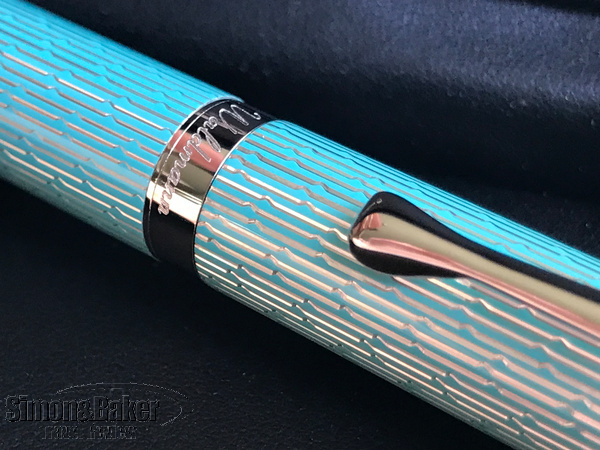
by Editor | Nov 22, 2021 | Products
By Elena del Valle
Photos by Gary Cox and Elena del Valle
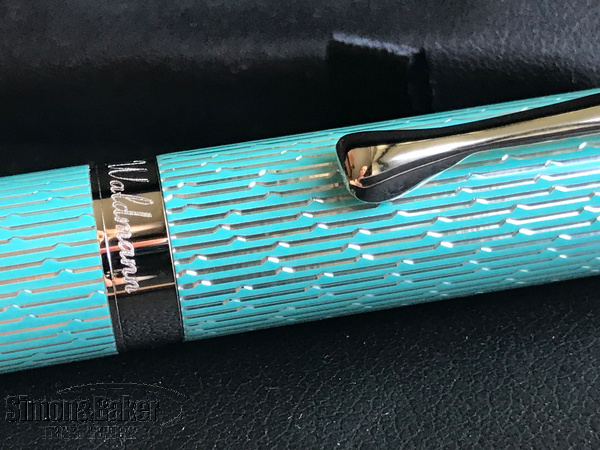
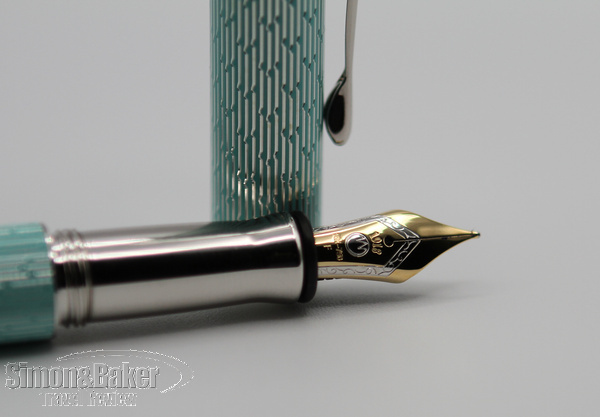
Close ups of the Waldmann Tango Imagination fountain pen with fine stainless steel nib
The folks at Luxury Brands of America (159 Houston Road, Troutman, North Carolina 28166, luxurybrandsusa.com, bryce@luxurybrandsusa.com, +1 980-276-0020) kindly lent us two Waldmann fountain pens for a month. The Tango Imagination and Vela Tuscany pens were made in Germany of 925 sterling silver or metal with rose gold plating and include a 10-year warranty. The Tango Imagination body and cap are made of solid 925 sterling silver. The Tuscany barrel is brass covered in a Physical Vapor Deposition (PVD) brown lacquer and the cap is sterling silver plated in rose gold. The nibs are stainless steel. At the time of this writing retail prices started at $400.


The Waldmann Vela Tuscany barrel is brass covered. The top photo is enlarged to show design detail.
When asked about the pens Bryce Gillett, National Sales & Marketing Manager, Luxury Brands of America said by email: “Tango Imagination: New technique engraving the barrel and cap, then applying colored lacquer over the top of the engraving. Then they shave it down to show both the silver and lacquered parts of the pen then clear lacquer the entire pen for protection. This finish offers a visual effect that the finish is dancing on the pen when the light hits it in different ways. Vela Tuscany: Chocolate Physical Vapor Deposition Lacquered brass barrel with a sterling silver cap plated in rose gold. Vela is a constellation in the southern sky, which Waldmann has incorporated the essence of this into the design of the cap!” He also explained that Physical Vapor Deposition “…Coating refers to a variety of thin film deposition techniques where a solid material is vaporized in a vacuum environment and deposited on substrates as a pure material or alloy composition coating.”
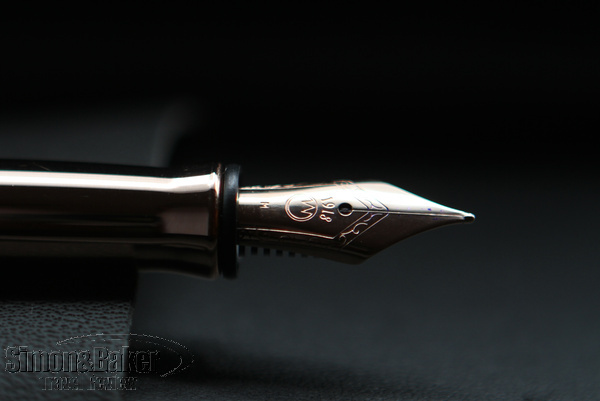
The Vela Tuscany stainless steel medium nib
Like the fountain pen concept, a throwback that predates our current era of digital communications. There is something luxurious about handwriting a note. It implies caring enough to make the time to find pen and paper to write a message. Writing with a fountain pen is often a pleasure. It was with these pens. Since the ink can be recharged the fountain pens seem more eco-friendly than common pens, especially disposable pens, which nine times out of ten don’t work when I reach for one.
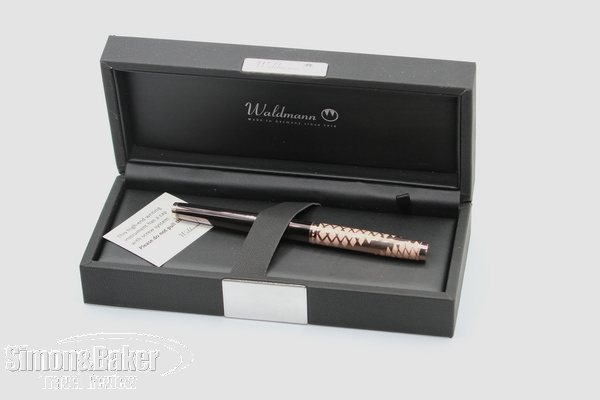
The Vela Tuscany in its case
What makes these two pens special? Several characteristics appeal to me. I liked their distinctive pretty designs and solid feel. Some of my older fountain pen models, decades old, haven’t aged well. Invariably it’s the resin pens. One is so frail a repair shop declined to attempt to extend its life. I like that the two loaner pens are made of metal, I suspect metal will age better than resin. That they were crafted by skilled artisans seems promising. In that regard the 10 year Waldman warranty is reassuring. I also like that they’re available through United States retailers.

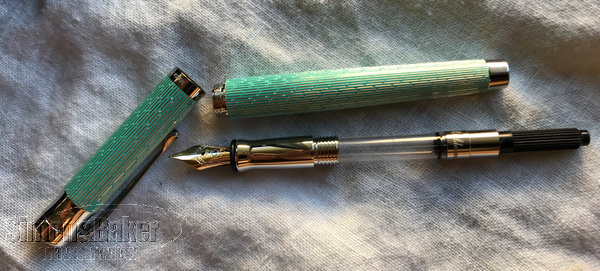

The Tango Imagination body and cap were made of solid 925 sterling silver.
When asked about the pen cases Gillett said they “are leatherette and feature a false bottom which will hide the Waldmann warranty card, sterling silver cap tag, and cartridges as well as any other information cards that that specific to that pen may specifically have. The box also features a metal opening tab of jewelry quality for an elegant look and feel when opening the box.”
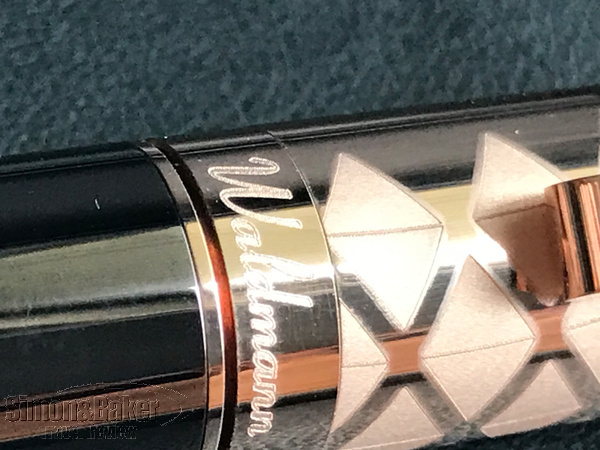
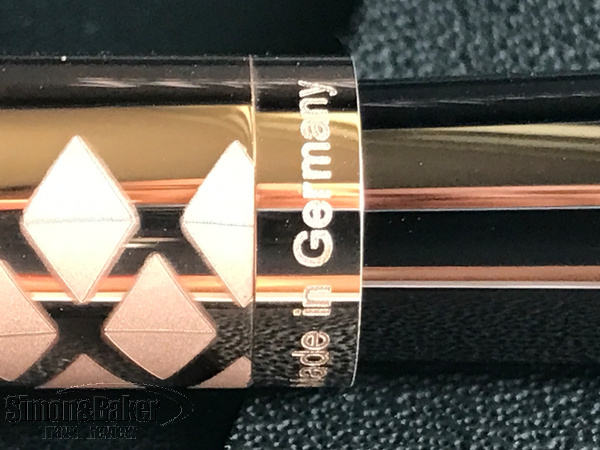
Close ups of the Vela Tuscany
Both wrote well on a variety of paper. The silver and green model (Tango Imagination) was my favorite of the two, eye catching yet elegant.
According to Gillett Waldmann pens are 100 percent made in Pforzheim, Germany by skilled craftsmen. Luxury Brands, founded in 2014, is a family owned and operated distributor of fine writing instruments, fountain pen inks, leather and accessories.

by Editor | Oct 28, 2019 | Food, Products
By Elena del Valle
Photos by Gary Cox
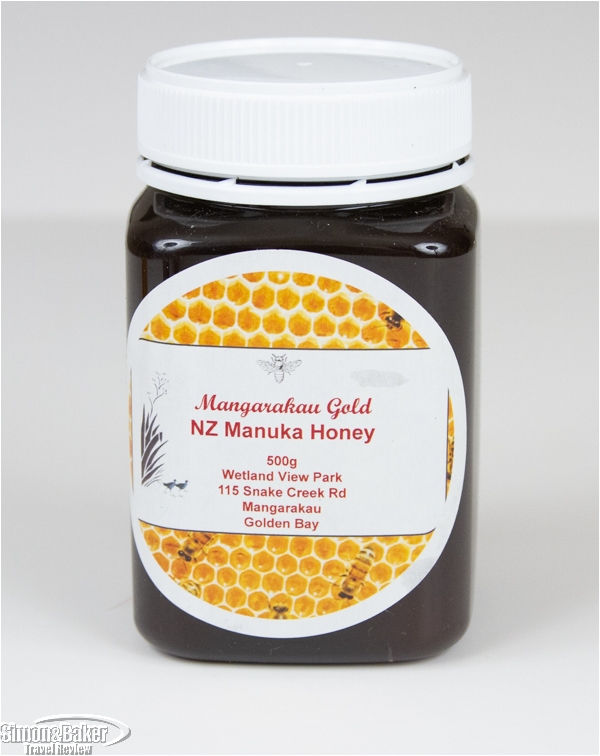
My favorite manuka honey was Mangarakau Gold from Westhaven Retreat
Soon after I arrived in the South Island of New Zealand for an Intrepid tour I sampled a spoonful of dark brown crusty honey with a hint of bitterness that captured my interest. It was an inconspicuous self sampling of Mangarakau Gold from an open container at the reception desk at Westhaven Retreat that made me stop and pay attention to New Zealand’s claim to honey fame, manuka. I bought a jar. I had passed by honey products advertised in many places in Christchurch before that. I have sampled many honeys over the years. This tasted special.
I bought a small jar of manuka honey at a health food store in Lyttleton near Christchurch in the South Island. The honey I bought at Westhaven, labeled Mangarakau Gold, is in a plastic jar. At 500 grams it is the largest of the three and my favorite despite (or perhaps because of) its hint of bitterness. The second honey, labeled Rochfort Downs, is in a 250 gram plastic container. Aotea, the store bought honey, is in an 80 gram glass jar. According to the label, it was processed by hand from hives on Aotea Great Barrier Island. It includes a batch number. There was no response to emails at the Aotea honey address. The Rochfort Downs and Aotea labels indicate they have 300+ MGO.
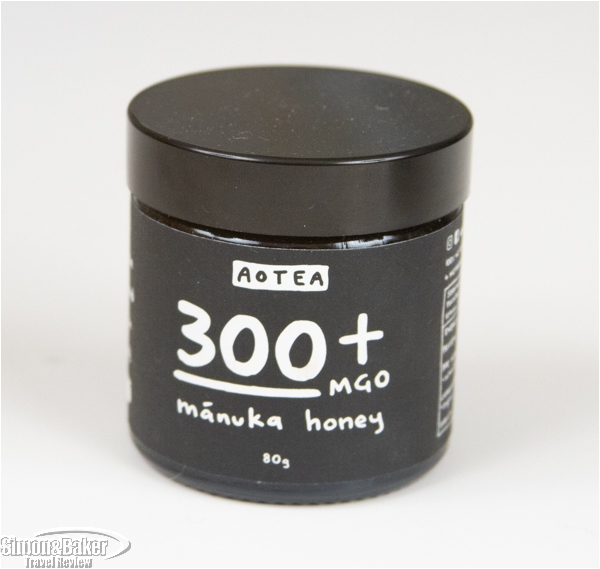
I bought a small jar of manuka honey at a health food store in Lyttleton.
Once home I tried the Westhaven honey as well as honey from Birds Ferry Lodge, clover honey from Cabot Lodge and the Aotea honey. Each one is distinct and slightly different from the others. This is especially the case with the Cathedral Peaks Honey, because it is clover rather than manuka honey, from Cabot Lodge. It was harvested by one of the owners on the 2,000 acre property. As their regular product was not ready for the public they kindly shared a 100 gram bottle (labeled Meant to B) from their recent wedding.
When I asked them about their honey they replied, “Brad’s family is heavily involved in agriculture and horticulture, his great grandfather was a prize ram breeder, his father is a large avocado and capsicum grower and his uncle is a beekeeper. For a while Brad left behind his agricultural roots to pursue a corporate career, but he always felt something was missing. One night he rolled over in bed and told me he wanted to become a beekeeper. I thought he was joking, as at that time we lived in the middle of Auckland City. He borrowed a few beehives from his father, and began to learn the art of beekeeping. Within six months he was determined to make it a career, and within 12 months we had packed our bags, moved to the other end of New Zealand to my parents farm, and Brad purchased 75 hives to begin his beekeeping dreams.”
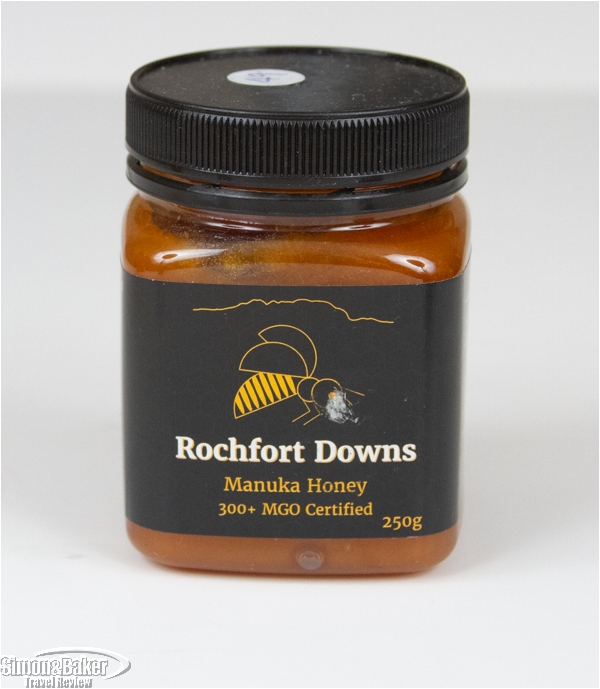
The Rochfort Downs honey in a 250 gram plastic container
Although I sampled the original manuka honey several times and the others I picked up on that trip I can’t put my finger on what it is that I like about them. In the end I decided to stop trying and savor the flavor along with the pleasant memories of my trip to New Zealand the honey evokes.
People I spoke with on my journey explained that manuka is known for its healing properties, wound healing in particular. Online resources tout its benefits for oral health, sore throat, digestive issues and other conditions (see 7 Health Benefits of Manuka Honey, Based on Science by Kaitlyn Berkheiser, a registered dietitian, published March 29, 2018 on Healthline.com) and a honey expert I spoke with support the concept.
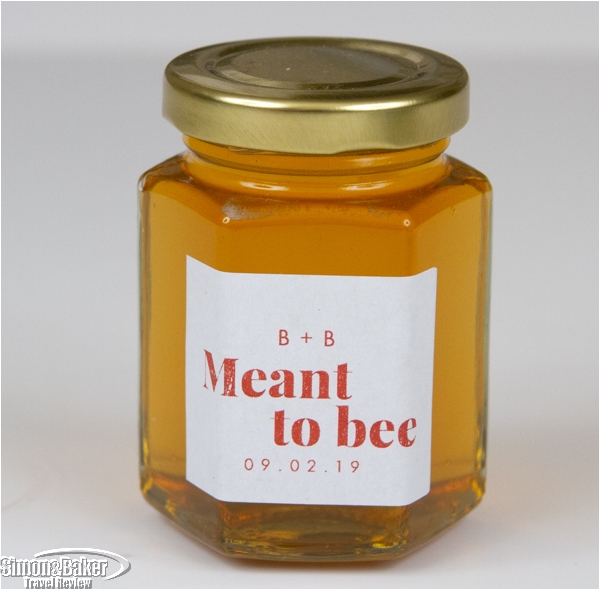
Clover honey from Cabot Lodge
While stateside honey is considered only a natural sweetener, not a drug, some believe honey, and manuka honey in particular, has healing properties. It has apparently been successfully used to treat wounds. Michele Colopy, program director, Pollinator Stewardship Council, an Akron, Ohio non profit organization, confirmed that credible sources describe manuka honey as having high concentrations of methylglyoxal (MGO), an antimicrobial and antibacterial naturally occurring substance described in the manuka honey bottles. Some believe that the higher the MGO concentration the greater the healing power of the honey.
She clarified that any honey, even those described as monofloral (made from a single type of flower such as orange blossom or lavender, for example), is the product of more than one type of flower. Bees get bored, and, it’s unhealthy for them to rely exclusively on a single plant source for nutrients, she explained by phone.
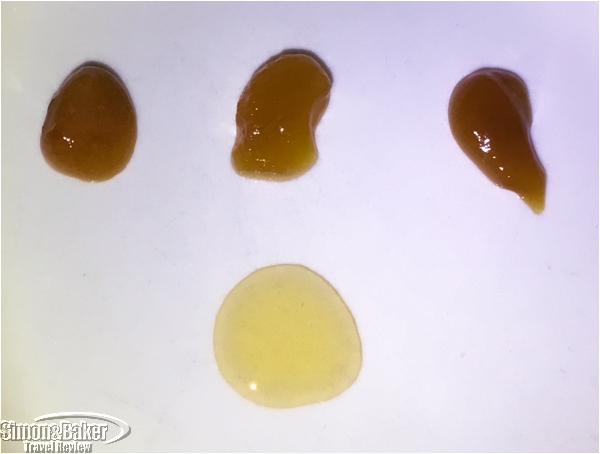
The thick and dark manuka honeys and the light colored clover honey
All four honeys I sampled where from small producers. Unless I return to New Zealand for another visit it will be difficult to buy more manuka honey from those small producers. The good news is that since my return home I have noticed many local stores have New Zealand manuka honey. Should I run out it will be easy to buy more even if it’s likely to be from large commercial producers. The honey I have left (more than I will eat in a year) will keep forever. Michele pointed out that honey never spoils. It would be possible to eat honey from the Egyptian tombs without any ills effects, she said. While I have no (immediate) plans to test honey from tombs for now I’m happy to occasionally enjoy a spoonful of thick liquid sweetness harvested by New Zealand honey bees. And if the honey includes healing benefits the better.
by Editor | Jan 22, 2019 | Attractions, Luxury Travel, Products
By Elena del Valle
Photos by Gary Cox and Elena del Valle*

The exterior of the Maison Tournaire shop steps away from the famous place Vendome
It was a chilly and clouded Friday afternoon when I arrived at Maison Tournaire (7 place Vendôme, Paris, France, +33 4 77960884, www.philippetournaire.com, mathieu.pallay@philippetournaire.com), a stone’s throw from the famous Place Vendome in Paris, France for a small group half-day workshop in French. Perhaps because of the well-known venue and crowded streets it was the kind of activity I suspect most tourists never know exists. It had been raining on and off all day. Despite rushing I was five or ten minutes late. As soon as I entered the boutique the staff made me at ease, explaining the workshop had yet to start. While I was still near the door another attendee arrived, distressed at being late. She had been circling the area in search of a parking place for a long while, she explained, making me feel better about my own tardiness.
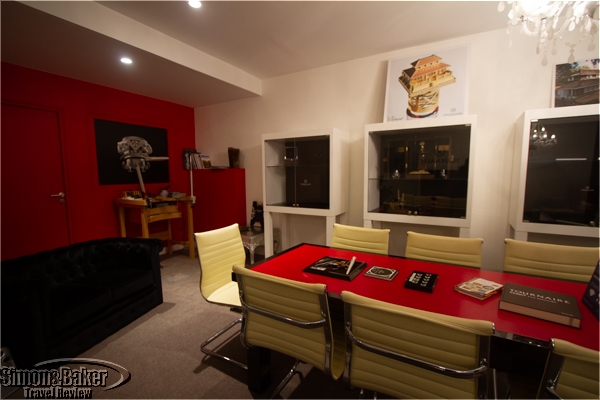
The meeting room where the workshop took place
The interior of the shop was well lit and populated with jewel filled glass cases. It was elegant without being intimidating, adult yet youthful. Marie, one of the two staff members, put away our wet raincoats and umbrellas, offering us welcome hot beverages in exchange.
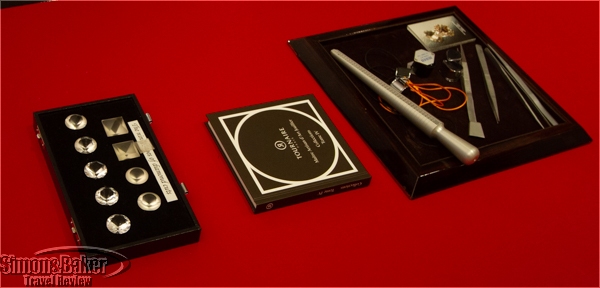
Some of the tools and materials we used during the workshop
After greetings from our host Mathieu Tournaire we climbed one floor upstairs where we sat at a conference table. Mathieu and I had an opportunity to chat earlier that day when he explained everything the company makes is Tournaire-ized. “We don’t just make jewelry, we tell stories,” he told me with a serious expression in between private appointments with clients. The clean shaven jeweler had a quiet confidence that bellied his youthful appearance and the easy manner of a salesman.
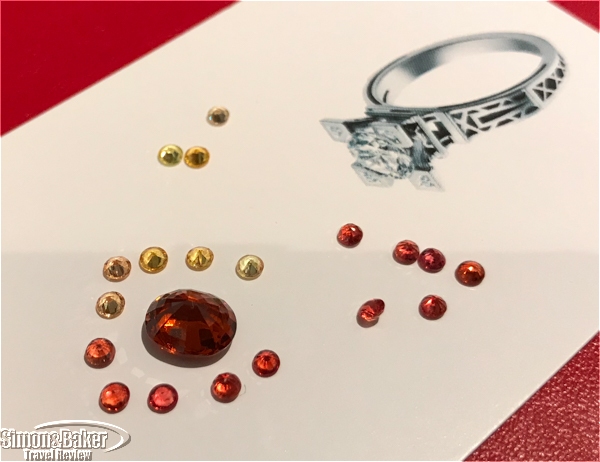
We initially discussed a ring design that could include my yellow and orange sapphires and possibly a large house stone.
Some 15 percent of Tournaire sales were custom orders, he explained. He and his father, Philippe Tournaire, were the creative engines of the firm and both lived outside of Paris. In addition to the Paris location there were stores in Lyon (4 rue Childebert) and Savigneux (2 rue des métiers), where they lived. Whenever he was in town his calendar was full of client appointments.
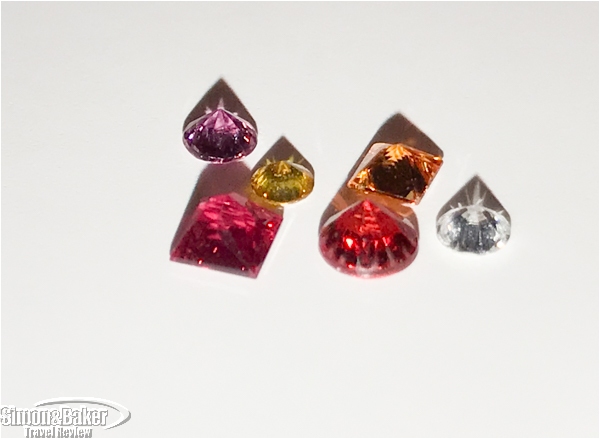
Stones Mathieu selected for the ring
More than half of the attendees had cancelled their workshop reservations because of the soggy weather or the ongoing Yellow Vest demonstrations that riddled France for weeks and peaked on weekends so in lieu of the original nine we were only four. The small group and easy manner of the other attendees made the workshop intimate, allowing each of us to hold tools, rough stones and gemstones in our hands, and observe them with loopes.
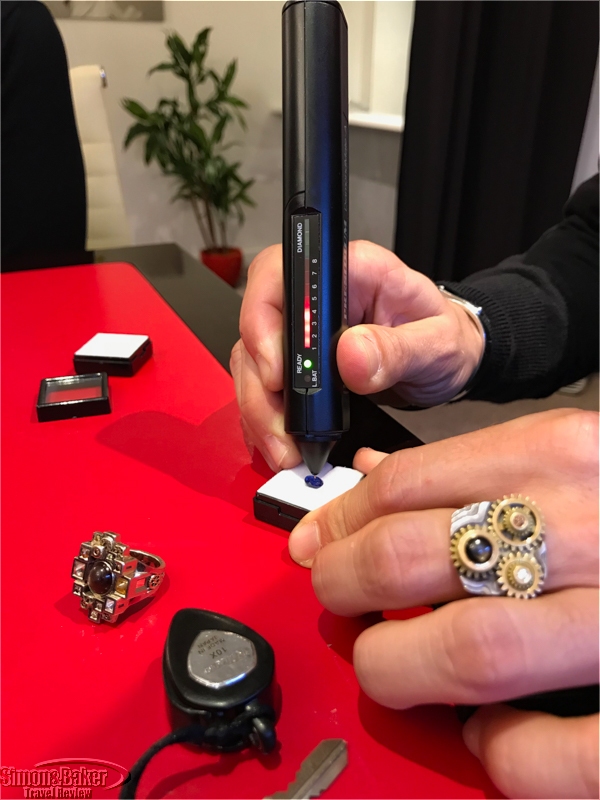
Mathieu demonstrated the use of a device to test diamonds
Mathieu held up a tablet to show us photos, discussing weights, measures, gemstone classifications, varieties and hardness, diamond colors, cuts and facets and demonstrated how to test a diamond with an electronic device. He explained that in France only diamonds, emeralds and sapphires (including rubies) are precious stones. He also discussed opals and star sapphires in passing. Time flew and before I realized it the workshop had ended. At its conclusion we each received a stamped certificate or Certificat de Participation as a souvenir.
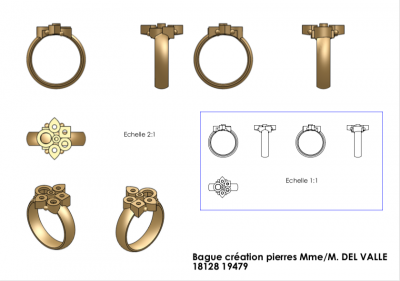
An image of the 3D model for the ring Mathieu designed (*courtesy of Maison Tournaire)
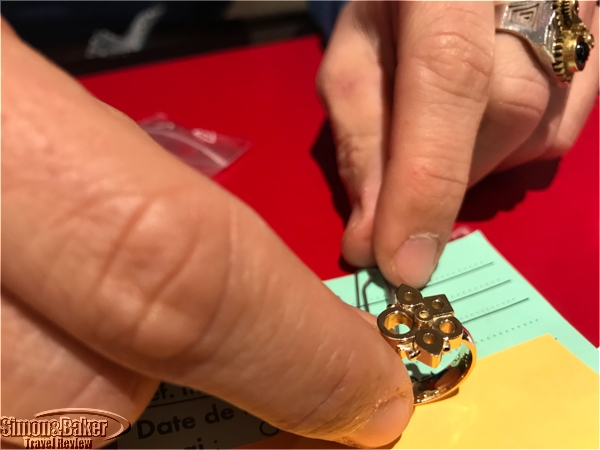
The ring setting Mathieu designed without stones, just the yellow gold part
Once the workshop was over Mathieu spent private time with several of the attendees. Earlier in the day he and I had discussed an idea for a custom made ring. He had drawn a Tournaire-ized concept on a piece of paper and shown me some small gemstones for possible inclusion (diplomatically rejecting my own stones). If all went well, he would share a 3D design via email before making a ring to show me before I left France.
Outside it was dark, but at least the rain had slowed to a drizzle. I didn’t mind the rush hour crowds and wet pavement so much as I walked back to the rue de Rivoli and south toward the Left Bank remembering my fun afternoon.
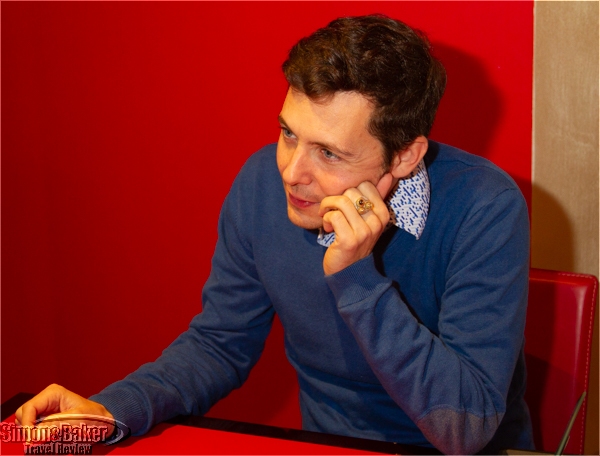
Mathieu Tournaire, artistic director, Maison Tournaire
Maison Tournaire was founded by Philippe Tournaire, a self taught jeweler, in 1973. Mathieu, the artistic director, joined the team in 2008. Maison Tournaire creations were designed to be easily recognized. I had an opportunity to see several of the lines and try on some of the pieces at the shop such as Engrenage (Mathieu wore a distinctive ring of that line), Alchimie, Pensée Sauvage, French Kiss, and Architecture. The ring he created reminded me of the Marélie line, a favorite along with French Kiss.
I liked that Tournaire products were made 100 percent in-house and in France. I appreciated the warm authentic service and efficient follow through. Where attendants at other shops I visited in the place Vendome area were solicitous their welcome was superficial, their demeanor stiff and cool. For example, an eager saleslady on the rue de la Paix offered tax free processing, but could not answer simple questions about the treatment or provenance of her gemstones. Mathieu answered my queries quickly and candidly. One overly inquisitive vendor at a nearby luxury boutique promised to email me information about items they expected to receive, but I never heard from him. In contrast Mathieu and his staff were helpful and responsive without ever being pushy. After the workshop he followed up promptly with the drawing and 3D design we had discussed. Likewise Marie was in touch promptly to schedule a new appointment.
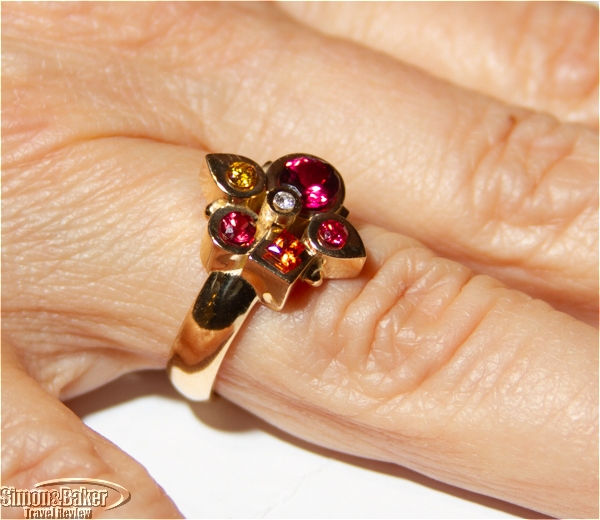
The stones resting on the setting allowed us to see how the finished ring might look.
Two weeks later when Mathieu returned to Paris he brought a 12 by 15 millimeter 18 karat yellow gold ring to show me. It weighed 8 grams and was priced at 3,900 euros. The stones he selected were: 5 millimeter tourmaline rubellite (a red tourmaline), 3 millimeter round red sapphire, 3 square millimeter orange sapphire, two color diamonds of 0.06 carats each, and a white 0.04 diamond. The ring was unfinished, but by placing the gems in their settings it was easy to imagine what it would look like. I especially liked that the diamonds were slightly elevated to protect the other stones. As the hardest stones diamonds would take the brunt of any impact if the wearer banged the ring by accident.
The ring was temptingly pretty. It reminded me of a friend’s redesigned and repurposed wedding ring after her divorce. Every time she looked at it her eyes sparkled with delight. Despite my interest by then my budget had already been fully allocated. Who knows, the next time I am in Paris and have a milestone to celebrate I might pop into Tournaire and say hello. I wouldn’t hesitate to recommend the workshop to friends with an interest in French jewelry wanting an off the beaten track experience in Paris. I would also recommend the shop to those in the market for the brand’s distinctive style.
by Editor | Sep 11, 2018 | Food, Products
By Elena del Valle
Photos by Gary Cox
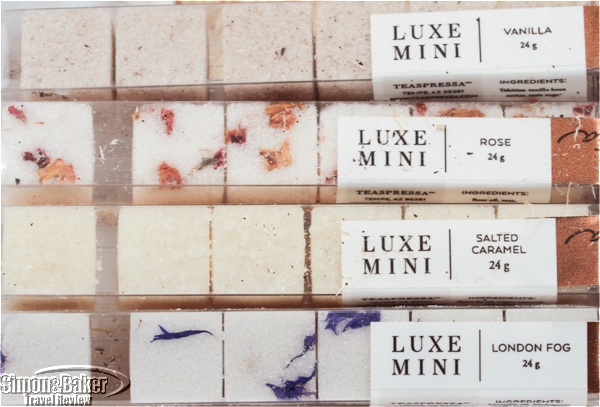
Flavored sugar cubes from the Teaspressa Starter Kit
Years ago in a small cafe in Stellenbosch, South Africa I had a memorable red tea made like an espresso. The resulting beverage was concentrated and small with the rich flavor of South African red tea. Recently, an at home tasting of four loose leaf teas from the Teaspressa Starter Kit reminded me of that delicious beverage. Teaspressa (Arcadia Signature Cafe, 4628 E Indian School Road, Phoenix, Arizona 85018, +1 917-710-5748, www.teaspresssa.com, info@teaspressa.com) is a new Arizona company founded by Allison DeVane. She created Teaspressa’s proprietary Tea Concentration Technology that uses a pressure extraction method to produce tea blends that, like espresso, can be used to make Tea Lattes, tea-based drinks comparable to gourmet coffee beverages.
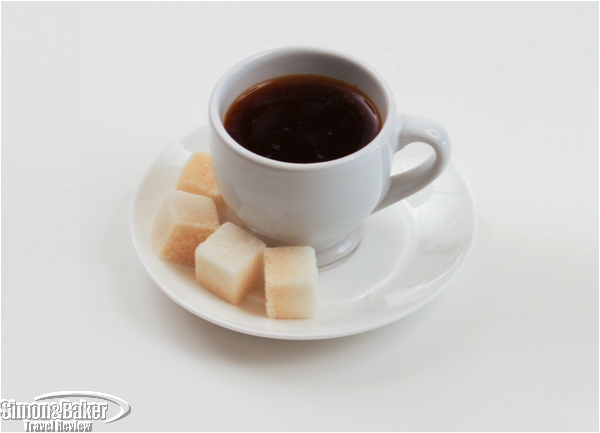
A tea shot and flavored sugar cubes
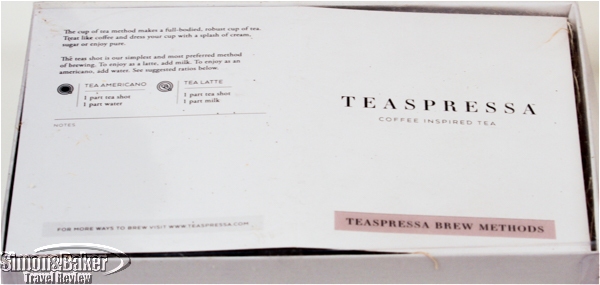
Our Starter Kit arrived in the mail with a black espresso pot, four teas, and four packages of flavored sugar cubes.
”Teaspressa is the first and only beverage that is a hybrid of tea and coffee, resulting in a healthy alternative to traditional caffeine drinks,” DeVane, who is also owner of the company, said by email via her publicist when asked what is special about her company’s teas. “Using a patented production process, Teaspressa is concentrated tea that contains as much caffeine as an espresso shot, but provides consumers the health benefits of traditional tea blends.
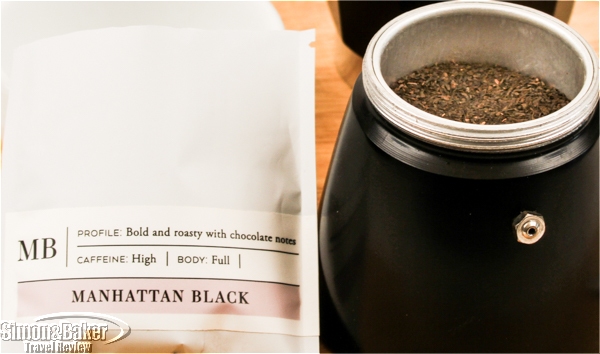
Manhattan Black, one of four teas in the Starter Kit.
Teaspressa is made similar to a shot of espresso, and has the same amount of caffeine; however, Teaspressa does not contain coffee, it is a concentrated tea that is made using a pressure extraction method, resulting in Teaspressa’s products containing all of the health benefits found in traditional tea. Just like espresso, Teaspressa can mixed with milk and more to create lattes and other gourmet coffee-like beverages, but with tea. Teaspressa can be made at home easily and similarly to traditional coffee, so consumers don’t lose their morning coffee ritual.”
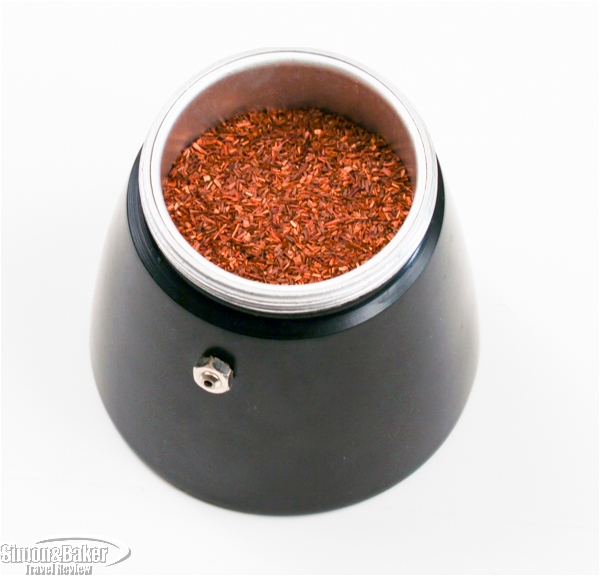
Red tea, naturally free of stimulants, in the espresso pot before brewing
Our Starter Kit arrived in the mail with a black espresso pot, four bags with several servings of tea each, and four packages of flavored sugar cubes. The teas, blended in Phoenix, were Manhattan Black, proprietary black tea and German rye; Cape Town, naturally caffeine-free rooibos and rye; Green Gold, proprietary green tea blend; and Charles Grey. There were four Luxe Sugar Stick flavors, handcrafted by Teaspressa using all-natural ingredients: London Fog, Rose (recommended by DeVane with champagne), Salted Caramel and Vanilla.

The teas, blended in Phoenix, were Manhattan Black, Cape Town, Green Gold, and Charles Grey.
According to DeVane, Teaspressa’s products are certified organic by the United States Department of Agriculture and made from “all natural, artisan loose-leaf tea blends, authentically sourced from China, Germany, South Africa, India and Japan.” She explained that the signature tea blends “underwent multiple phases of testing and are specialty curated for the brewing method that is similar to coffee brewing.”
Three of us, all tea fans, sampled and liked the teas and their concentrated flavor. We made them using the espresso pot per the instructions that came with the package. While none of us sweetens our tea we tried the sugar cubes, each less than 10 calories per cube and made with sugar from Hawaii, according to DeVane, on their own and also liked them. My favorites were London Fog and Rose in that order. The two men preferred Salted Caramel and Vanilla.
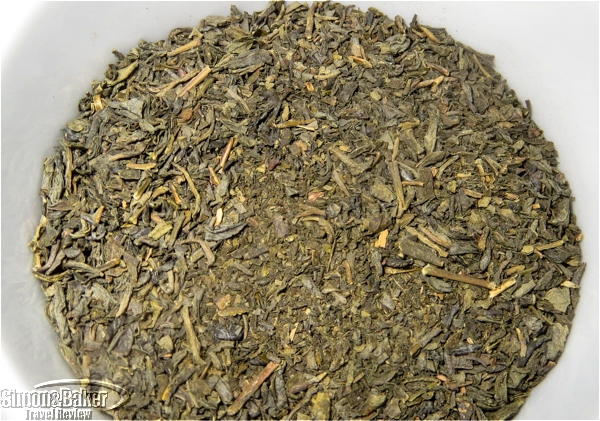
The Green Gold
The Teaspressa tea shots were especially appealing when time was limited such as at the end of a meal and when in the company of espresso drinkers. In lieu of the longer time it takes to savor and drink a cup of tea or a pot of tea sometimes it would be nice to have a tea shot. The teas were available via the company website as well as at Teaspressa Ann Arbor Signature Cafe (414 S Main St #115b, Ann Arbor, Michigan 48104) and Teaspressa Frank Lloyd Wright Kiosk (12621 N Frank Lloyd Wright Blvd, Scottsdale, Arizona 85259).
by Editor | Aug 6, 2018 | Products
By Elena del Valle
Photos by Gary Cox
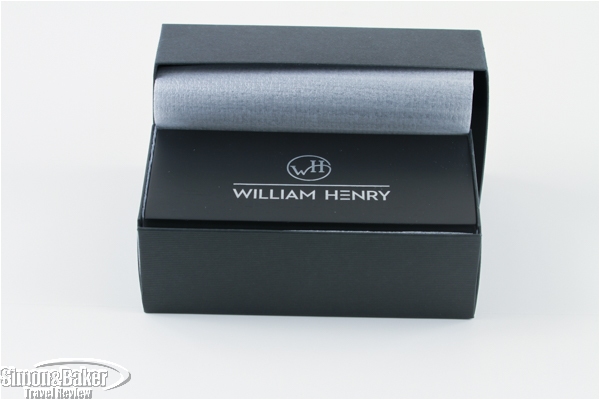
Each pen was packaged in an attractive, sturdy box.
While electronic devices have reduced our need for handwriting to almost nothing they can’t replace the pleasure of holding a fine writing instrument. A tiny bit of joy fills me with every letter I write using a pen or better yet a fountain pen. There is something about the weight of a pen resting between my fingers and the smooth flow of ink onto paper that transports me to a higher plane.

The pocket clip was set with a tiny blue sapphire from Swarovski Gems.
Usually disposable pens are safest when traveling. At the same time, leisure trips sometimes provide opportunities to indulge in writing for pleasure and I miss my nice pens. So it was that I chanced on an idea recently: to take a matching set of handcrafted pens, a rollerball and a fountain pen, William Henry Cabernet RB8-1101 and William Henry Cabernet F8-1101 respectively, from William Henry (William Henry, 3200 NE Rivergate St, McMinnville, Oregon 97128, +1 503 434-9700, www.williamhenry.com, sales@williamhenry.com) on a local trip. As of this writing the fountain pen has been discontinued.
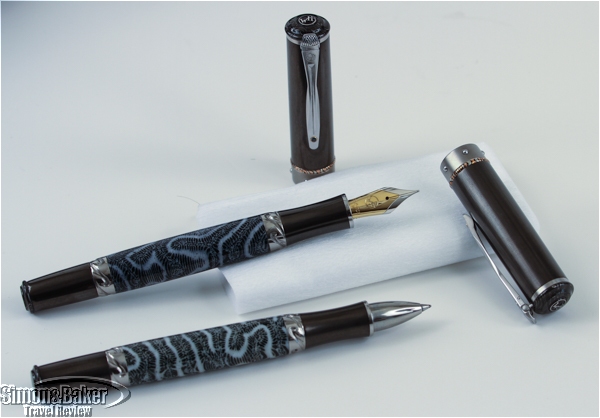
With their caps on I was unable to tell the two pens apart. Once the caps were off it was immediately clear which was which.
I tried the rollerball pen, which retails for $1,600, first. It felt solid yet not heavy and wrote with ease. When a road trip popped up I decided to take both pens rather than leave the untested fountain pen behind. I happened to have a fuchsia leather pen case for two in which they fit.

One of my favorite features was the patent-pending Wavelock™ cap closure system.
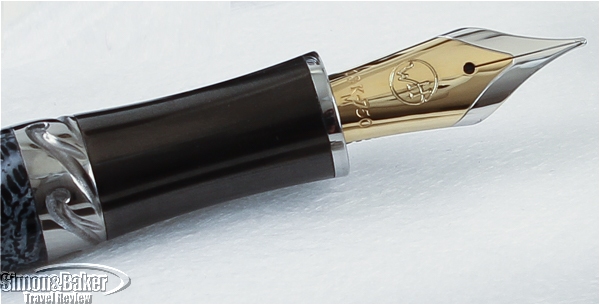
The fountain pen (now discontinued) had a dual tone white and yellow 18 karat gold nib.
During the trip, I charged the fountain pen with the single black ink cartridge that came in the case. It took a couple of tries until the ink came out. And, it seemed to require more pressure than I use on my other fountain pens. Once I became accustomed to it I liked the fine elegant letters I was able to form thanks to the German made dual tone white and yellow 18 karat gold medium nib. After a few hours it required several tries to get the fountain pen ink to flow. Placing it in a sealed snack size plastic bag when not using helped a bit, but as of today it still requires scribbling for a few minutes with little to show for it or placing the tip in cold water or running water. This has happened to a lesser extent with other fountain pens.
I liked the understated unisex style of the pens, which require four months to make. Stabilizing the coral takes time, a spokesperson explained by email. In both pens the pocket clip was set with a tiny blue sapphire from Swarovski Gems. The sapphires are from Nigeria, Madagascar or Sri Lanka.

I took both pens on a road trip in a fuchsia leather pen case for two I had.
The pens were made with rare materials, 100,000 year-old fossil coral from the Florida Keys for the barrel and aerospace grade titanium and aluminum. The accents on the carbon fiber cap were from Mokume Gane, a Japanese metalworking procedure, which produces a mixed-metal laminate with distinctive layered patterns, and hand forged Damascus steel. William Henry only manufactured 250 pens in each of the two models.
One of my favorite features was the patent-pending Wavelock™ cap closure system, “a ring of chromium steel balls embedded in a titanium ring captured in wave-shaped grooves in titanium collars for closed and post positions.” The design meant there was always a place for the pen caps, which if I paid attention when I attached them to the pen body always remained secure in place whether the pen was open or closed.
Ink spills and stained leather cases have taught me to avoid flying with fountain pens. Still I miss them during extended trips. Perhaps in the future I will take only the rollerball when I fly, hoping its outer appearance will keep me from missing its fountain pen partner too much.
I was hesitant about selecting a product from a men’s catalog, wondering if the pens would be masculine, heavy or bulky. I need not have given it a thought. I later discovered that about 23 percent of William Henry customers are women. According to a spokesperson, some 75 percent of them purchase a gift, while one quarter purchase for themselves.
There were many features I appreciated about the pens and the company behind them. It began with the distinctive limited production pens themselves as well as the company policies. One of the first to catch my attention was that the products were completed and shipped from the William Henry studio in Oregon. From the hefty case each pen arrived in to the details of the sapphire on the clip and a WH on the top of the pen cap the products were as pretty in person as on the website. And they felt solid yet well balanced when writing. The rollerball is now the first pen I reach for among the many writing instruments on my desk.
William Henry, a small maker of artisan products in Oregon, was founded in 1997 by Matt Conable, the brand’s creative director. The company seeks to work with “some of the most skilled and talented craftsmen, artists and engravers in the world to create products that are timeless, exclusive and strike a personal chord with their owners.” William and Henry are the middle names of the two company founders.
by Editor | Jan 22, 2018 | Luxury Travel, Products
Article and photos by Gary Cox
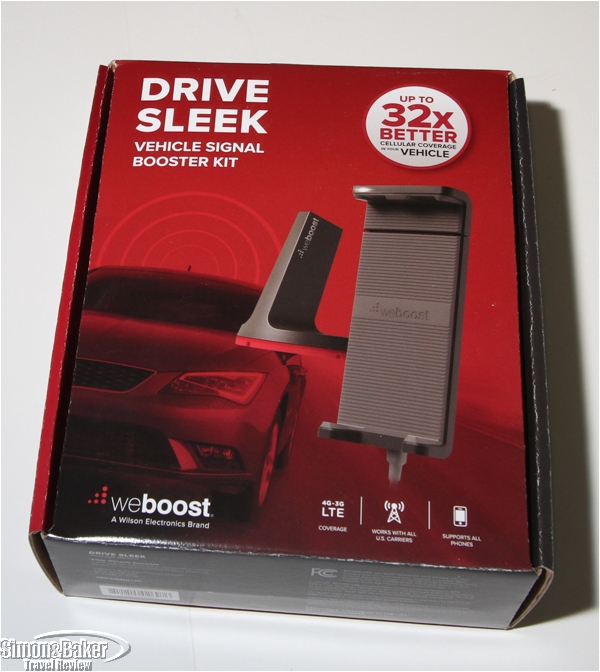
The weboost Drive Sleek Vehicle Signal Booster Kit
Cellular reception in Palm Beach County, Florida for our carrier varies from great to non-existent as we drive around during the course of a weekend, running errands and visiting the beach. Dropped calls are common, and there are places where the signal is so weak that a call cannot be completed. That was why we took advantage of the opportunity to try out the new Drive Sleek Vehicle Signal Booster Kit from weBoost (3301 E. Deseret Drive, St. George, Utah 84790, +1-866-294-1660, https://weboost.com, support@weboost.com). The .55 pound device was designed and assembled in the United States with foreign parts, according to the box.

The box contained a detailed manual and a number to call for help.
Our kit contained an antenna with a magnetic base, a signal booster, a 12 volt power plug, a cradle for the phone and the cables to connect them together. The parts were labeled with numbered stickers that designated the installation procedure. I placed the antenna on the rear deck of our mustang convertible and ran the cord into the trunk. The booster’s Velcro like attachment and some cable wraps made it simple for me to affix it to the lining in the trunk behind the backseat. I was able to fit the cables up and around the seat, tucked out of the way for the most part, except for the jump to the center console where the power plug resides.
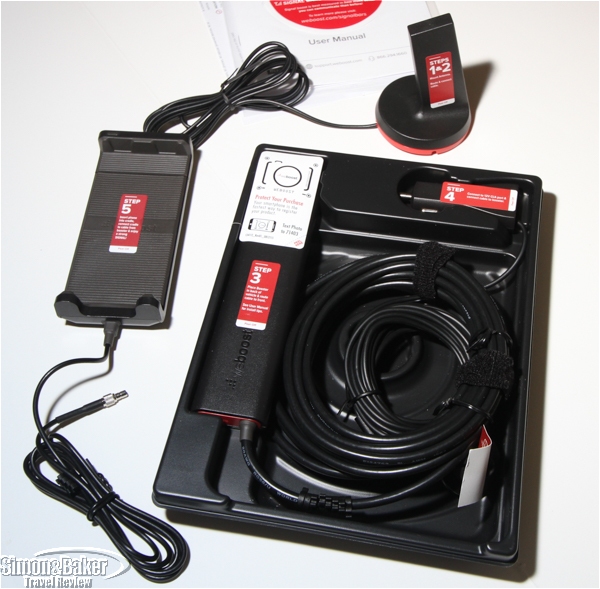
The components had numbered stickers showing the installation order.
The cradle came with an attachment to fit the vents on some cars, but was just not practical in the vents on the mustang. The vent mounting (a little split cone with a magnetic back) helped keep the cradle from sliding off the center console. The cone on the back of the cradle fit into a cup holder and stayed put under normal driving conditions. The power plug must be disconnected when not in use as it continues to draw power even without the car running. A light on the cradle indicates that it is powered up. I prefer to unplug it rather than risk that in a rush I might leave it hooked up and return to a dead battery. It is not clear how long it would take to run the battery down.
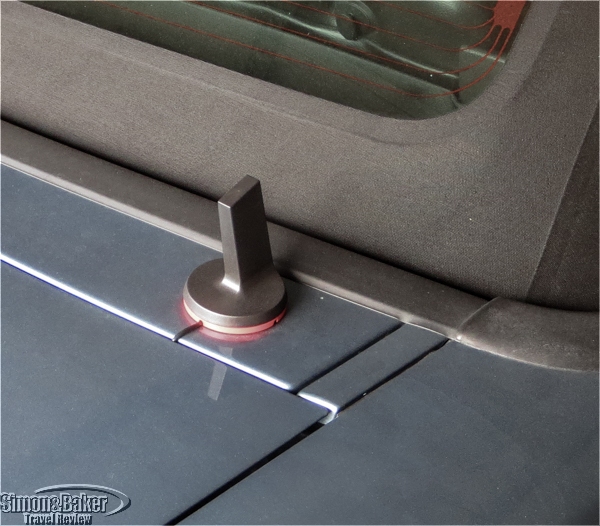
The magnetic antenna mount held securely between the trunk and the soft top
As soon as I placed a phone in the cradle, the effect of the booster was visible in the number of signal bars on the display. A hands free, either Bluetooth or wired is necessary for comfort and according to the user manual. The Federal Communications Commission (F.C.C.) requires that users never hold the device in the cradle up to their ears. Some local municipalities require the use of a hands free headset from drivings using a mobile phone. Our iPhone has the hands free jack on the top, so it had to be inserted into the cradle upside down. Once there it then remained in the spring loaded slot. After several trials with the new configuration, we managed to maintain calls while driving across the county without any drops or loss of signal, and the mobile phone worked in what previously were dead zones.
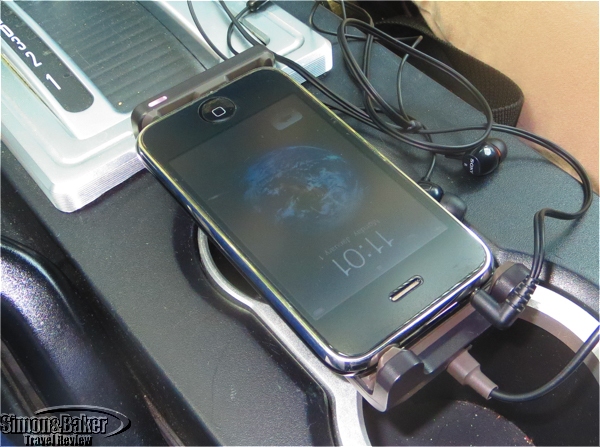
The phone secured in the cradle with the hands free cable attached.
According to the manufacturer, the boosted signal will extend battery life, which makes sense although we did not test it as a specific benefit. More than anything, it was nice to use the phone and maintain a conversation while running our errands or traveling, and reassuring to know that if we had an emergency or car trouble (other than a dead battery), we would be able to make a call even in the former dead zones. We have been satisfied with weBoost Drive Sleek Vehicle Signal Booster Kit and would recommend it to friends looking to increase the mobile phone signal in their cars.






















































